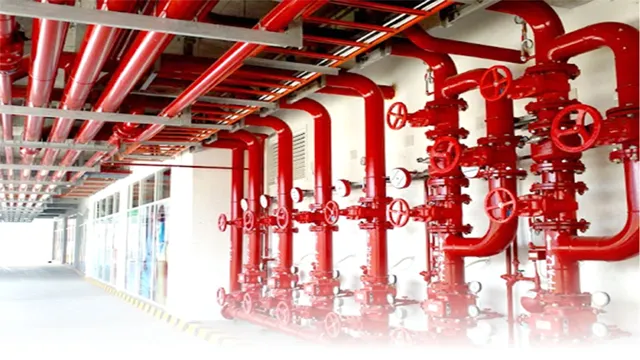Ensuring Patient Safety: The Ultimate Guide to Electrical Systems in Healthcare Facilities according to NFPA Standards
Electricity is a necessary component of healthcare facilities. However, electrical systems can also pose potential risks to the safety of patients, healthcare providers, and hospital assets. Proper planning, installation, and maintenance of such systems are vital to maintain the quality of care and the overall safety of the facility.
The National Fire Protection Association (NFPA) has developed the “NFPA Guide to Electrical Systems in Healthcare Facilities”, which is a comprehensive guide that exclusively aims to minimize the risks of electrical hazards in healthcare facilities. It provides a detailed set of guidelines that help architects, electrical engineers, and healthcare facility managers with critical information needed for designing, installing, and maintaining electrical systems in healthcare facilities. The guide ensures compliance with the latest codes and standards, including the National Electrical Code (NEC), NFPA 70E, and Joint Commission Accreditation Standards for Healthcare Facilities.
This blog will explore the importance of the “NFPA Guide to Electrical Systems in Healthcare Facilities” and highlight key elements that healthcare facility managers must consider to protect their patients, staff, and equipment from electrical hazards.
Why is the NFPA Guide important for Healthcare Facilities?
The NFPA Guide to Electrical Systems in Health Care Facilities is an essential resource for any healthcare facility. This comprehensive guide provides standards and guidelines for operating, maintaining, and testing electrical systems in healthcare environments. Healthcare facilities require a higher level of safety and reliability than other buildings due to the critical nature of patient care.
Electrical systems in these facilities must be designed, installed, and maintained to provide continuous and reliable power to medical equipment and devices. The NFPA guide covers everything from grounding requirements to electrical safety checks to emergency backup systems. Healthcare facilities must comply with these standards to ensure the safety of patients, staff, and visitors.
Adhering to the NFPA guide will help healthcare facilities prevent potential electrical hazards and ensure the safety and well-being of everyone in the facility.
Reducing Electrical Hazards in Healthcare Settings
As we all know, healthcare facilities are prone to electrical hazards, and this is where the NFPA Guide comes into play. It is extremely important for healthcare facilities to follow this guide to reduce electrical hazards. By implementing the guidelines recommended by the NFPA, healthcare facilities can ensure the safety of their employees, patients, and visitors.
The NFPA guide covers a wide range of topics related to electrical safety such as electrical room requirements, electrical equipment installation, and electrical maintenance procedures. By following the guidelines, healthcare facilities can reduce the risk of electrical fires, electrocution, and other hazards. The NFPA guide is updated every three years to keep up with the latest electrical safety standards, which makes it an invaluable resource for healthcare facilities.
It is essential for every healthcare facility to stay up-to-date with the latest electrical safety standards by following the NFPA guide to ensure the safety of everyone involved.

Compliance with Industry Standards and Regulations
Healthcare facilities must comply with various industry standards and regulations to ensure the safety of their patients and personnel. One such guide that is crucial for healthcare facilities is the National Fire Protection Association (NFPA) guide. The guide outlines specific standards for fire safety, emergency preparedness, and life safety.
These standards are intended to prevent the occurrence of fires, limit the damage they cause, and promote the prompt evacuation of patients and staff in the event of an emergency. Compliance with the NFPA guide is essential in maintaining a safe environment in any healthcare facility, helping to reduce the risk of injury or even loss of life. As a result, it is necessary for healthcare organizations to ensure that their facilities are up-to-date with the latest NFPA codes and standards.
By doing so, healthcare facilities can provide optimal care for their patients while keeping everyone safe in the event of an emergency.
Key Features of the NFPA Guide for Electrical Systems in Healthcare Facilities
The NFPA guide to electrical systems in healthcare facilities is a crucial resource for ensuring the safety and reliability of electrical systems in healthcare settings. Key features of this guide include detailed requirements for electrical systems in different areas of healthcare facilities, such as patient care areas, critical care areas, and diagnostic and treatment areas. The guide also provides guidance on backup power systems, including emergency generators and uninterrupted power supplies, as well as recommendations for testing and maintaining electrical systems to ensure they are functioning properly.
Additionally, the NFPA guide outlines specific requirements for electrical equipment and wiring, such as grounding and bonding, to minimize the risk of electrical hazards. Overall, following the guidelines in the NFPA guide can help healthcare facilities ensure the safe and effective operation of their electrical systems, promoting the well-being of both patients and staff.
Detailed Guidelines for Electrical Installations in Healthcare Facilities
Electrical Installations in Healthcare Facilities When it comes to healthcare facilities, it’s crucial to ensure that the electrical systems are not only reliable but also safe for patients and staff. The National Fire Protection Association (NFPA) has provided guidelines for electrical installations in healthcare facilities, which include several key features. Firstly, the guide emphasizes the importance of regular maintenance and testing of electrical systems to minimize the risk of electrical hazards.
Secondly, it outlines the specific requirements for different types of healthcare facilities, such as hospitals, clinics, and nursing homes. It details the electrical system design, including wiring, grounding, and circuit protection. Additionally, the guide highlights the importance of proper installation of life safety equipment, such as smoke detectors and emergency lighting.
Accommodating the specific electrical needs in these facilities is important to ensure that the critical systems receive reliable power; and provide a safe and healthy environment for both patients and staff. Thus, incorporating the NFPA guidelines in the design and installation of electrical systems in healthcare facilities is necessary to ensure safety, reliability, and compliance.
Requirements for Electrical Safety in Patient Care Areas
When it comes to patient care areas, electrical safety is of utmost importance. The National Fire Protection Association (NFPA) has laid down guidelines for electrical systems in healthcare facilities that ensure the safety of both patients and staff. Some of the key features of the NFPA guide include regular testing and maintenance of all electrical equipment, protection against electrical hazards such as shocks and arcs, and the use of ground fault circuit interrupters (GFCIs) in areas where water is present.
Additionally, healthcare facilities are required to have emergency electrical systems in place that can operate under abnormal conditions and ensure that critical equipment such as ventilators and monitors remain fully functional during a power outage. It is crucial for healthcare facilities to adhere to these guidelines to ensure the safety and well-being of their patients and staff.
Guidelines for Maintenance and Inspection of Electrical Systems
The National Fire Protection Association (NFPA) has developed guidelines for maintenance and inspection of electrical systems in healthcare facilities. These guidelines aim to reduce the risk of electrical hazards and ensure that equipment remains in good condition. Some of the key features of the guide include regular inspections of all electrical equipment, including wiring and circuit breakers.
The guidelines also stress the importance of keeping a record of all inspections and maintenance activities. Additionally, the guide recommends that all electrical equipment be maintained by trained professionals and that any faulty equipment be promptly repaired or replaced. Following these guidelines can help prevent electrical fires and other hazards in healthcare facilities, ensuring the safety of patients, staff, and visitors.
Overall, adherence to these guidelines is vital in ensuring that electrical systems in healthcare facilities remain safe and functional.
How to Implement the NFPA Guide in Healthcare Facilities
If you’re working in the healthcare industry, it’s essential to be familiar with the NFPA guide to electrical systems in health care facilities. This guide outlines the best practices for designing and maintaining electrical systems in healthcare facilities to ensure safety for patients and staff. To implement the NFPA guide, you need to start with a risk assessment to identify potential electrical hazards.
From there, you can create a plan to address any issues and make necessary upgrades to your electrical infrastructure. It’s also crucial to prioritize regular inspections and preventive maintenance to identify any potential problems before they become a safety concern. By following the NFPA guide, you can maintain a safe and reliable electrical system in your healthcare facility, ensuring the well-being of everyone who enters its doors.
Appointing a Qualified Electrical Contractor
In order to ensure the safety of healthcare facilities, it is crucial to implement the guidelines provided by the National Fire Protection Association (NFPA). This includes the appointment of a qualified electrical contractor who is experienced in working with healthcare facilities and familiar with the unique codes and regulations that apply. Hiring someone without this specialized knowledge could lead to serious safety hazards for both patients and staff.
When selecting an electrical contractor, it is important to consider their credentials, experience, and reputation. It is also essential to communicate openly about the specific needs and requirements of the healthcare facility to ensure the contractor is able to provide the necessary services. By carefully choosing and working with a qualified electrical contractor, healthcare facilities can help prevent electrical hazards and ensure the safety of all those who enter.
Conducting Electrical Safety Training for Staff Members
As a healthcare facility, it’s essential to prioritize electrical safety by conducting training for staff members. Implementing the National Fire Protection Association (NFPA) 70E Standard can help employers create a safe and compliant work environment for the team. In the healthcare industry, electrical hazards are relatively common due to the nature of the equipment used.
The NFPA 70E Standard offers guidelines that emphasize safety protocols, including employee training, hazard assessments, and proper labeling of equipment. By incorporating the NFPA 70E guidelines, healthcare facilities can enhance their electrical safety practices, minimize the risk of electrical injuries, and promote an overall safer work environment. It’s crucial to ensure staff members understand the dangers of electrical hazards and the potential consequences.
Providing training sessions that teach them to recognize electrical hazards and how to take precautions can help to reduce workplace hazards and promote a safer work environment. Employers must also encourage employees to report or identify any potential electrical hazards to reduce the risk of injury. Overall, implementing the NFPA 70E Standard in healthcare facilities can be a game-changer in ensuring a safe work environment for both the staff members and the patients.
Conclusion
Much like a skilled surgeon relies on a steady hand and precision tools to perform a successful operation, a healthcare facility relies on a reliable and safe electrical system to provide the highest level of care to patients. The NFPA Guide to Electrical Systems in Health Care Facilities serves as a vital resource to ensure that electrical safety never takes a backseat to the needs of patients and healthcare professionals. It’s a reminder that when it comes to healthcare, every detail matters, including the electrical systems that keep everything running smoothly.
“
FAQs
What is NFPA 99?
NFPA 99 is a standard that provides guidelines for electrical systems in healthcare facilities to ensure patient safety.
Why is it necessary to follow the NFPA guide for electrical systems in healthcare facilities?
The NFPA guide is important because healthcare facilities require special attention to electrical systems to maintain a safe patient environment and prevent electrical fires.
What are some of the key requirements in the NFPA guide for electrical systems in healthcare facilities?
Some key requirements outlined in the guide include testing and maintenance of electrical systems, backup generators, and appropriate grounding to prevent electrocution.
What are the consequences of not following the NFPA guide for healthcare electrical systems?
Failure to follow the NFPA guide can result in an increased risk of electrical fires, electrocution, and non-compliance with safety regulations, potentially leading to legal consequences for the healthcare facility.





